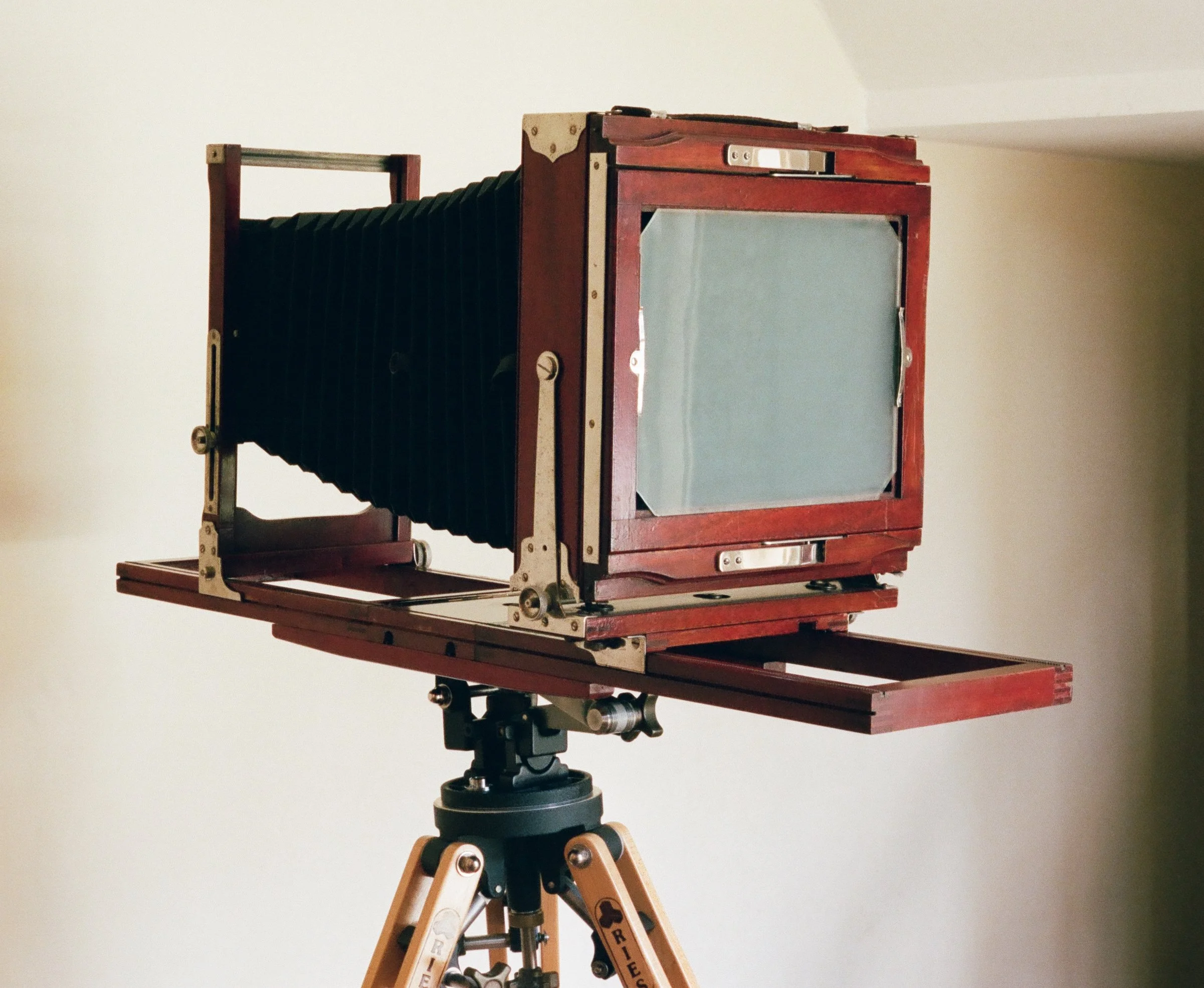6 1/2 x 8 1/2 Korona View
Monolith, the Face of Half Dome (Ansel Adams, 1927) was made with one of these.
6 1/2 x 8 1/2 Korona View on a Ries tripod and head. (Color photos of the camera were made with a Nikon F, 55mm f/3.5 Micro-Nikkor-P.C, and Portra 400.)
6 1/2 x 8 1/2 Korona View with 255mm E.F. f/4.5 Bauach & Lomb Tessar Ic. No shutter. Both camera and lens were made in Rochester, N.Y.
6 1/2 x 8 1/2 Korona View
Glass plate project
One of my favorite photographs is Ansel Adams’ Monolith, The Face of Half Dome (1927). It was made with a 6 1/2 x 8 1/2 Korona View, a ‘Tessar-formula lens of about 8 1/2 inch focal length’, a red filter, and a panchromatic glass plate (Adams, 1983). Shortly after, Adams used the same camera on a Sierra Club-sponsored trip to the Canadian Rockies (Adams 1985:115).
In the early 2000s, as digital photography took over, I was anxious about the future of film. What if it all went out of production? Could I make my own? I ruled that out but home-made glass plates seemed worth a try.
My 6 1/2 x 8 1/2 camera outfit closely matches Adams’ description and it came with plate holders. With Reed and Jones (1996) as a guide, I prepared some plates.
Glass plate project, no. 1 Pacific Palisades, Calif. 6 1/2 x 8 1/2 Korona View, 255mm E.F. f/4.5 Bauach & Lomb Tessar Ic, homemade glass plate, early 2000s.
Process
A building materials store cut a half-dozen pieces of glass for me. Using a brush, I hand-coated them with Knox unflavored gelatin and Rockland Liquid Light photo emulsion. This yielded low sensitivity orthochromatic plates,
I set up a shot in a quiet location. Figuring on ASA (ISO) 5, eight minutes of exposure was about right. This was slow enough that the lens cap served as a shutter.
I tray-developed the plates in Dektol. They were well exposed but only two were usable. With the others, the emulsion didn’t adhere well enough to the glass. I made contact prints on Oriental Seagull Grade 2 fiber-based paper and the results are here.
Glass plate project, no. 2 Pacific Palisades, Calif. 6 1/2 x 8 1/2 Korona View, 255mm E.F. f/4.5 Bauach & Lomb Tessar Ic, homemade glass plate, early 2000s.
Results
The prints have some problems (or features). The emulsion thickness was uneven, there are brush strokes and bubbles, and the coating was fragile. The result was imperfections that make the images very unlike Ansel Adams’. Maybe more like 1950’s abstract painting.
Conclusion
This was an art project and an exploration of potential substitutes for photo film. Today, film availability is less of a problem so I’ve placed my glass plate effort on hold for now.
References / further reading:
Adams, Ansel. 1983. Examples: The Making of 40 Photographs. Boston: Little, Brown.
Adams, Ansel. 1985 (paperback edition, 1996). An Autobiography. Boston: Little, Brown.
Kingslake, Rudolf. 1989. A History of the Photographic Lens. San Diego, Calif.: Academic Press.
Reed, M. and S. Jones. 1996. Silver Gelatin: A User's Guide to Liquid Photographic Emulsions. New York: Amphoto.
Stroebel, L. 1993. View Camera Technique, 6th ed. Boston: Focal Press.
Weston, Edward (Nancy Newhall, ed.) 1990. The Daybooks of Edward Weston: Two Volumes in One. I. Mexico, II. California. New York: Aperture. The dust jacket features a well-known photo of Weston with a Korona view camera (incorrectly identified as a Seneca).
Appendix: More on the camera and lens
The Korona View was a standard large format camera in the first half of the 20th century. They were built in formats formats ranging from 4x5 to 12x20, maybe more. Ansel Adams and Edward Weston used them extensively.
The Tessar lens, designed in 1902 by Paul Rudolph of Zeiss (Kingslake, 1989), was used on all sorts of cameras throughout the 20th century including view cameras, the Graflex, the original Hasselblad, various Rolleiflex models, many Zeiss Ikon 35mm and medium format cameras, and even the point-and-shoot Yashica T4 of the 1990s.




